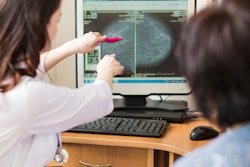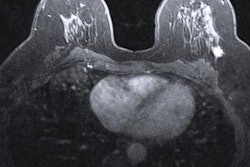
The use of artificial intelligence (AI) in breast imaging is growing, but there are a few issues radiologists should consider before using AI in daily practice, according to a keynote speech given May 5 at the American Roentgen Ray Society (ARRS) meeting in New Orleans.
In his presentation, Dr. Cody Mayo from the University of Texas MD Anderson Cancer Center talked about the future of AI in breast imaging practices and how radiologists can prepare for its imminent regular use, as well as what's needed from AI for medical imaging in general.
"The question is not how AI is going to affect us, but when," Mayo said. "We're obviously moving into the wild west as it were with AI. In fact, we've made enough of an impression that government is now getting involved."
AI is used in practice by about 30% of radiologists, with larger practices leading the way, according to a survey published in 2021 by the Journal of the American College of Radiology (JACR). The same survey also reported that of practices that don't use AI, 20% plan to purchase AI tools in the next one to five years.
"In 2017, that [overall use] was about 17%, and in 2015, it was 0," Mayo added.
The JACR survey also listed what radiologists wanted from AI tools. Lesion detection and anatomic measurements led at 73% and 71%, respectively. Worklist prioritization was third at 62% and then image quality followed at 58%.
Recent research has touted AI's performance as being close to or equivalent to that of radiologists, and the U.S. Food and Drug Administration (FDA) has begun approving some algorithms for clinical use. The FDA in 2021 also released its "Artificial Intelligence and Machine Learning Software as a Medical Device Action Plan" to address AI's medical use and create a regulatory framework.
However, challenges remain for building and deploying algorithms used in radiology, including breast imaging, Mayo said. These include insufficient or low-quality input data, confidentiality concerns, lack of long-term outcomes data, lack of reimbursement, and finding staff support roles for smaller practices.
Since most current AI software is designed to be used autonomously to interpret images, Mayo said radiologists should make sure AI is integrated into radiology workflow in a way that makes sense. This could include using AI to help with patient scheduling and identifying appropriate screening exams.
"This means we don't need extra monitors or workstations in order to review," Mayo added. "It needs to be seamless."
So, what should breast radiologists consider when thinking about implementing AI into their respective practices? Mayo listed several, including the following:
- Review individual needs and available products.
- Read available literature and attend conference.
- Engage with vendors for more information.
- Consider all points of view through group discussions.
- Check for references, on- and off-sheet if possible.
- Request a trial for AI tools being considered for purchase.
- Purchase tools if they fit the clinic's needs.
Mayo also reviewed future opportunities that practices may take advantage of. These include narrowing the gap between vendors and clinics, using blockchain for reports, images, and electronic medical record data among other uses, and using quantum computing.
"Smaller companies had the first-mover advantages. They were nimble and developed some algorithms on some smaller datasets, but that has not really gained traction in the deployment of these systems," Mayo said. "What we're seeing is that a lot of larger hospitals and academic institutions are starting to try to create their homegrown algorithms and possibly bring industry in a supporting role. This is probably going to continue."




















